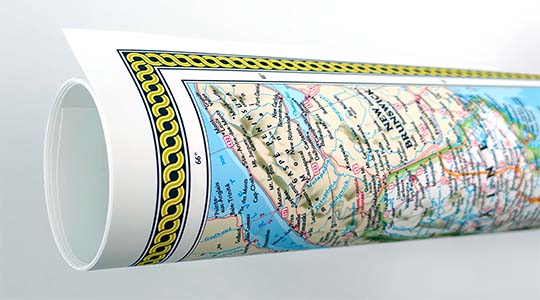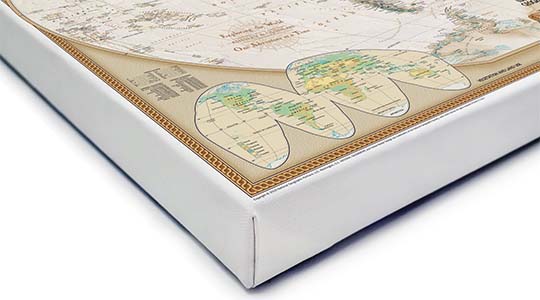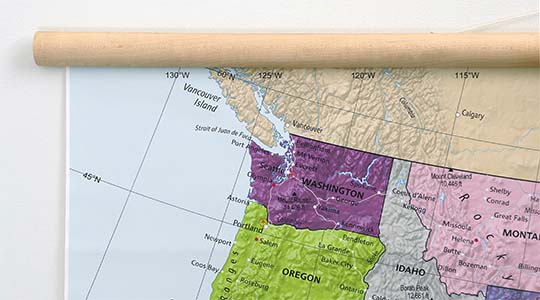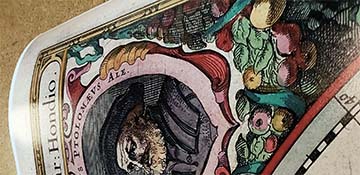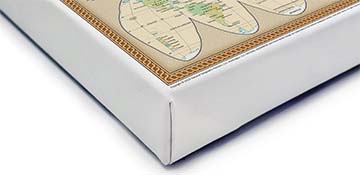Pictorial view map of Oconomowoc, Wisconsin, published by the Marr & Richards Engraving Co. in 1890, reprint. Like many other towns in Wisconsin, U. S. development began in the 1830's and 40's. This map includes the "Lake Region of Waukesha County" and notes that "All these Lakes and Resorts are within Four Hours ride of Chicago, on the Chicago, Milwaukee & St. Paul Railway."
The article below appeared in the "Oconomowoc Enterprise" newspaper in July, 1915. The article is a transcription of a paper prepared by Miss Mary Newnham and read by her at a meeting of the Ladies' Social Circle of the Congregational church in 1910.
Features numbered & lettered references to the following locations:
HOTELS AND SUMMER RESORTS. P. O. ADDRESSES.
A. Jones House, Oconomowoc, Wm M. Jones, Proprietor.
B. Townsend House, Oconomowoc, Frank P. Hord, Proprietor.
C. "Woodlands House", Oconomowoc, David W. Small, Proprietor.
D. Draper Hall, Oconomowoc, Chas. B. Draper, Proprietor.
E. Gifford's, Oconomowoc, Geo. B. Gifford, Proprietor.
F. Sanitarium, Oconomowoc, Dr. J. H. Voje, Proprietor.
G. Spring Bank, Oconomowoc, Mrs. J. A. Burtis, Proprietor.
H. Interlachen, Hartland, Dr. J. A. Rice, Proprietor.
I. Hawthorne, Hartland, W. H. Simonds, Proprietor.
J. Lakeside Cottages, Hartland, D. W. Fowler, Proprietor.
K. Nagowicka Cottage, Delafield, Geo. B. Audley, Proprietor.
L. Nestledown Cottage, Delafield, W. E. Coon, Proprietor.
M. Oakton Springs, Pewaukee, Polacheck & Clason, Proprietors, C. L. Clason, Manager.
N. Nashotah Hotel, Pewaukee, L. W. Warr, Proprietor.
O. Fountain Spring House, Waukesha.
P. Hyde Park Hotel, Waukesha.
Q. Spring City Hotel, Waukesha.
R. Park View Hotel, Waukesha.
S. Park Hotel, Waukesha.
T. Fox River House, Waukesha.
SPRINGS.
I. Arcadian Springs.
II. Silurian Springs.
III. Bethesda Springs.
IV. Hygea Springs.
V. Henk Springs.
VI. White Rock Springs.
THE LAKES.
1. Lac La Belle.
2. Fowler.
3. Oconomowoc.
4. Ashippun.
5. Okauche.
6. Upper Nashotah.
7. Lower Nashotah.
8. Upper Nemahbin.
9. Lower Nemahbin.
10. North Lake.
11. Pine Lake.
12. Nagowicka.
13. Keesus.
14. Beaver Lake.
15. Pewaukee Lake.
COMMUNITIES:
U. Delafield.
V. Harland.
W. North Lake.
X. Pewaukee.
RAILROADS:
OO Chicago, Milwaukee & St. Paul Railway.
XX Waukesha, Oconomowoc & Western Railroad.
XO Wisconsin Central Railroad.
OX Chicago & Northwestern Railway.
The following article was prepared by Miss Mary Newnham and read by her at a meeting of the Ladies' Social Circle of the Congregational church. It is full of interesting historical facts and pertains particularly to Oconomowoc and vicinity:
EIGHTY ODD YEARS AGO - Reminiscences of Oconomowoc and Vicinity.
"Eighty years or more ago this beautiful region of Oconomowoc was a wilderness, invested by savages and wild animals of various kinds. About that time, in 1827, a Frenchman named Vieau came to trade with the Indians. It is claimed that he was the first white man to ever set foot on Oconomowoc soil. In 1836, a few years later, other white men came. One of them built a shanty where the cemetery is at the present time located. A sawmill was soon built, and an addition built on to it to be used for the purpose of grinding wheat.
In 1837 others came to take up claims, or buy at a low price, by the acre, land near by. One of them erected a log house, which stood where the present home of C. K. Peck now stands and it was called the first house ever built in the village.
Among the first Episcopal services that were ever held in the village were held in this home. Lumber was brought from the mill by William Thompson and others to be used for seats. Dr. Adams of Nashotah was sent for to preach and hold the services, the choir members being Madame Rockwell and Mr. Collins.
A log cabin was built later on where Mr. Fitzgerald now lives on West avenue, and the first frame house was built on the land where Mrs. Rockwell now resides and was used as a boarding house to accommodate transients who passed through the place.
Also a house, three stories high with basement, was built on the lot where the H. K. Edgerton house now stands. It was built of planks set up edge-wise and fastened together with wooden pins. After a time it was torn down and the planks sold to the farmers to build shanties with. Then the first hotel was built there.
The first regular store was opened in 1847 and the first 4th of July celebration occurred that same year.
There was building known as "The Barracks" in those early days which was used for a tenement house, school house and hospital, at one time, containing eighteen patients. It was situated where the mill now is and moved away later on and used as a cooper shop.
One of the first buildings on Milwaukee street was a blacksmith shop and stood where Warr's shoe store now is. It stood on stumps that had been leveled off for a foundation, for that location was a marsh and men fished at night from a jack a lantern where the city hall is standing today.
The first church was built by the Methodists in 1849 and was located on the lot where Kurz's (now Kellogg's) drug store now stands. The lumber was furnished by George Williams who abandoned his plan of building a barn in order to get the church. The land was given by J. S. Rockwell, as in other instances churches had their beginning through his generosity. This church was used by all denominations for some time.
Grading streets and building sidewalks began; a lyceum was started, and an appeal was made to all clergymen, lawyers, merchants and people of all classes, both male and female, to turn out to this their first effort at intellectual improvement. Ladies' presence was especially solicited to give prosperity and encouragement to the association, and members were compelled to be accompanied by at least one lady or fined a peck of apples, to be used for the benefit of the association.
A band was organized. The Ladies' seminary was started (the Capt. Scudder residence), an infant school was opened by Mrs. Woodruff, whose name is so revered today by her loving scholars (the 49ers). Entertainments were many and of various kinds. Picnic parties from the city were met by the band and escorted to the village, where boats and vehicles were at their disposal, including sailboats. The beautiful island in La Belle lake was then a veritable flower garden and not private property as it is now, and many a picnic party enjoyed life to its fullest extent there in the days long gone by.
The first school house was built in 1842 on the Lisbon road, opposite the Schuttler place. It is still in use and owned by Mrs. Solveson.
The first child born in Oconomowoc was Eliza Dewey, born in 1840, while Charles Ferry was the first boy, born in 1841. The first death occurred that same year, that of Mrs. Foster. She was buried on Zion church point, but afterwards re-interred and placed in the cemetery which was then at the Marston grounds. Later her remains were removed to Nashotah Mission.
The first physician was Dr. Goodnow. His office was at Nashotah just where the health resort now stands, across the lake from Nashotah Mission.
The Mission was founded in 1838 and my father helped to cut the way over the hills in the wilderness for the first wagon track. Settlers were fortunate to have an ox wagon then to take their family to church in.
On Sept. 6, 1859, Bishop Payne of Africa, in the presence of Bishop Kemper and a few clergy, put the first spade in the ground for the foundation of the new chapel at Nashotah, the corner stone being laid on the 19th. This chapel was threatened by fire in May, 1909. The cloister, three hundred feet long, was in ruins when Chief Town and his men from here with their fire engine (also one from Hartland) arrived on the spot just in time to save the historic chapel. The theological seminary connected with this mission has ordained about 340 men for holy orders, since 1845, when Gustaf Unonias was the first graduate, and the first to officiate at Zion Episcopal church in Oconomowoc.
The first teacher of a public school in Wisconsin was Edward West. He took up a claim near Oconomowoc in 1842. He taught in Milwaukee in 1837 and was known as "the boy teacher". He died at the age of 85.
The saddest thing that happened was in 1839. The drowning of the sons of Russell Frisby. They were crossing the inlet of the bay on Oconomowoc lake, when their boat capsized. Their bodies were buried on the shore near where they met their sad fate.
In the year 1838 my father, in company with a party of hunters, followed the Indian trail leading from Milwaukee to Silver Lake, in search of game to be used for a game supper in Milwaukee. Attracted by the beauty of the scenery and the lake region, he decided to return later on, and took up a claim on Silver lake (now the Weinz estate). The first night he spent alone in a covered wagon with the exception of a pet house-cat, which bounded from side to side of the wagon box as the wolves howled around its sides in the wilderness. That year the old territorial road was in use. The little village of Summit, with its store, blacksmith shop and hotel, sprang into existence, expecting the new railroad would come her way. But when it laid its iron rails they were laid three miles to the north and Oconomowoc started to boom, and business finally died out in the little village. Her district school-house stands there proudly still and possibly a building or two of that date, but nothing else remains but farming or gardening interests. The electric road cut through her fine farming lands a few years ago and a little station is near her corners, but when the car stops the conductor calls our "Dousman road", thus robbing Summit of her birthright. The only road that led out of Oconomowoc in that year, 1838, was the one that led to Summit. She had established a post-office and not until 1842 did Oconomowoc have one. The mail was carried through Summit from Mineral Point to Milwaukee. Letter postage was twenty-five cents and as postage was not always prepaid, often letters would lie in the office for weeks as it was difficult to raise the amount demanded.
The earliest settler was obliged to walk to Milwaukee (30 miles) for pork and flour, the only products in the market at that time. He would start at daylight returning late in the evening with from 50 to 75 pounds of these provisions on his back and divide the same with his neighbors. Pork was $40 per barrel and flour $20. A man was known to carry a heavy Peekskill plow on his back cheerfully for 15 miles, as there was no other way for him to possess it. Wheat was at first thrashed with a flail and winnowed in the wind, afterwards hauled to Milwaukee for market at 50 cents per bushel. Twenty-five per cent interest was taken on borrowed money.
Fish and game, Johnny cake and pies made of turnips, saved the bravest from starving out. Even raccoons were considered a palatable dish.
Horses were seldom dreamed of, but he who possessed a yoke of oxen was proud to walk at their sides guiding them with whip and lash telling them to "haw", meaning they would turn to the left, or to "gee", which meant to the right, sometimes by the way of emphasis pushing the beast by his bodily strength the way he should go. Such a team was usually called "Buck" and "Bright". One man, however, who parted with his feather bed in order to gain possession of a yoke of oxen, named one "Hard" and the other "Times" in lasting memory of his sacrifice.
The early settlers was afflicted with fever and ague, called "shakes", occurring every other day, proving quite convenient, as the same member of the family did not all shake at the same time, and could care for each other during the intervals.
Even the hogs and cattle did not escape and would lean against the old rail fences when the "shakes" came on, causing the rails to rattle.
Instead of boats, rafts were used; pitchforks instead of spears, and the pitchfork was hastily grabbed at night when the half-clad settler would rush to the scene where the wolves were eating, alive, some of the few stock he possessed. Not risking his life, however, as the wolf has a preference for a man in full dress, and apt to run from one who has not stopped to make his toilet.
A pioneer mother did not need a barber shop, for she would place a small crock over her child's head and with the scissors would cut away what hair floated beneath the rim.
In the early forties, Winnebago and Pottowattomie Indians were camped around these lakes and were trouble-some to my mother. As a rule they were peaceable and appreciated and never forgot a kindness. They would borrow the dog and pay in venison. They would ask for the best wheat flour and never be deceived in the quality. After giving it to them she would tell them to "puckachee" to their wigwam and they would go in peace. At other times she would have to brandish her dagger in order to frighten them. When father was in Milwaukee or on a surveying trip and she knew they had drank too much "firewater", or in their language were "squibbly", she would allow them to sleep on the kitchen floor all night. In the morning they would depart saying "she was a good white woman". They had to be treated in a firm, but kind and tactful manner.
Oconomowoc had in 1859 1,000 inhabitants, three churches, the Congregational, Methodist and Episcopal; a newspaper, 12 inches by 17 inches in size; the Summit bank (now called Oconomowoc or Old Bank), two trains daily, one to Milwaukee and one from the same city, taking 2 1/2 hours to make the distance.
A school for boys was conducted where C. I. Peck's residence now stands. Oconomowoc had her own post-office in 1842. The postmaster had his trials, as he received a letter addressed to "the prettiest girl in town" and he said there were so many pretty girls then that he did not know which one to decide on.
Part of the east end of town was a cemetery. The west end was used for a race track, circus grounds, etc.. Where the slow ox team plodded along on the old plank road (Milwaukee street and West avenue) now automobiles, motorcycles and other swift vehicles are seen. The present generations would smile audibly to see today a yoke of oxen in our streets. But they had their place with the old settler and helped to "pave the way" with him. Few people realize the hardships, privations, and courage of those who knew Oconomowoc and vicinity in those early days of "Auld Lang Syne".
- Miss Mary Newnham |
